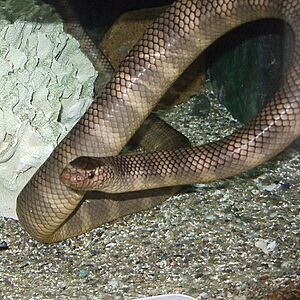Black-banded sea krait facts for kids
Quick facts for kids Black-banded sea krait |
|
|---|---|
 |
|
| Conservation status | |
| Scientific classification | |
| Genus: |
Laticauda
|
| Species: |
semifasciata
|
| Synonyms | |
The black-banded sea krait (Laticauda semifasciata) is a special kind of venomous marine reptile. It is also known as the Chinese sea snake. This snake spends time both in the water and on land. It belongs to the same family as cobras and mambas. You can find it in many parts of the western Pacific Ocean and some areas of the Sea of Japan. In Japan, people call it erabu umi hebi, which means 'erabu sea snake'. In Okinawa, it is simply called irabu.
This sea krait loves living near coral reefs. Its body shape helps it explore small spaces for food. It has a short head, a thick body, and a tail that looks like a fin. This fin-like tail helps it swim. The snake's stomach is quite wide. These kraits gather near the shore to lay their eggs in narrow cracks or caves in the reef. They are mostly active at night and are rarely seen during the day. Since they breathe air, they must come to the surface at least once every six hours.
Black-banded sea kraits are not fast swimmers in open water. So, they hunt by searching through the small hiding spots within coral reefs. They look for fish or other animals that fit their size. This way of hunting is similar to how some of their prey, like the moray eel, find food. Sometimes, these sea kraits even hunt with bluefin trevally fish. The sea krait searches the reef, and the trevally wait nearby. If the krait scares out a small fish or crustaceans, the trevally quickly catch them. The krait's bite is very venomous and can paralyze its prey. Female kraits lay their eggs on land.
Where do black-banded sea kraits live?
You can generally find the black-banded sea krait around the Coral Triangle. This area includes the Ryukyu Islands, Taiwan, the Philippines, and Indonesia.
Recently, scientists have found these sea kraits in the waters near southern South Korea. This area is usually outside their normal living range. Researchers believe that climate change is causing the kraits to move north from their usual homes. This is because their natural habitat might be changing due to warmer waters.
How do black-banded sea kraits grow?
Male and female black-banded sea kraits become adults at different sizes. Males are ready to reproduce when they are about 70 cm (28 in) long. Females become adults when they are about 80 cm (31 in) long.
Female kraits lay between 3 and 7 eggs. These eggs hatch after about 4 to 5 months. A black-banded sea krait can grow to be as long as 170 cm (67 in), including its tail.
Black-banded sea kraits and humans
The venom of the black-banded sea krait is very strong. Some say it is ten times stronger than a cobra's venom. However, like most venomous snakes, the black-banded sea krait usually does not bite humans. It only bites if it feels trapped or threatened. They prefer to save their venom for hunting food. Biting a human is usually a last resort for them.
Even though its venom is powerful, the meat of the erabu snake is a popular winter food in southern Japan. People there believe it can give them energy and make them feel stronger. A soup called irabu-jiru (ja:イラブー汁) is made from this snake. People say it tastes like miso and a little bit like tuna. This soup was a favorite of the royal family in the old Ryukyu Kingdom. It was thought to have properties that could help people recover their strength.
During some warm years, many sea snakes gather in sea caves and tide pools along the Ryukyu cliffs. They come to drink fresh water and sometimes to find mates. In these hidden spots, often at night and guided by lantern light, older women catch the black-banded sea kraits. These women are very skilled at preparing irabu-jiru. They explore the caves, sometimes barefoot, to find the snakes. They quickly grab the snakes behind the head to avoid being bitten. The snakes are then put into a cloth bag alive. Later, they are prepared in a simple broth with kombu (a type of edible kelp) and sometimes a little pork.


